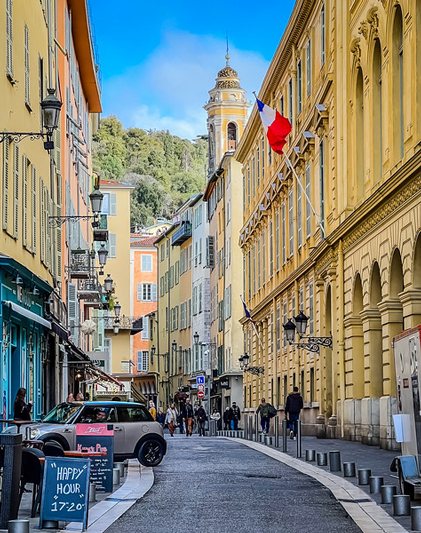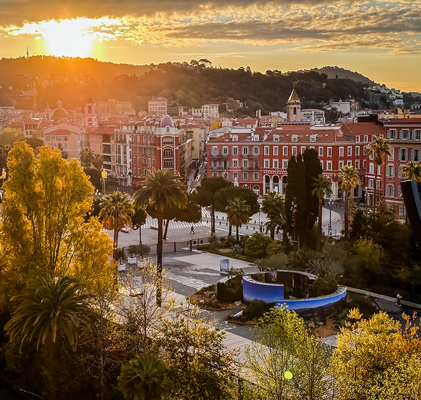The capital of the Côte d’Azur is a city with a rich artistic, cultural and architectural heritage. There are many interesting places to visit, and the Natural History Museum is one of them. You’ll discover the biodiversity treasures of this city and its region between land, sea and mountains.
Here are our tips for planning your visit to Nice’s Natural History Museum.

This guide is completely independent, based on our experiences. We visited the region anonymously, making our own choices and paying our bills in full.
Is a visit to Nice’s Natural History Museum worthwhile?
Did you know that Nice’s Natural History Museum houses a collection of over a million specimens in the fields of zoology, botany and geology? Located opposite the MAMAC Museum and nestling behind the Place Garibaldi, this venue offered us an excursion into the heart of the Mediterranean coast’s biodiversity. It was the 1st municipal museum to open in the city in 1846. The facility is richly documented and user-friendly, providing an ideal educational experience for children. In fact, it’s one of our top tips for things to do in Nice.

What you can see
You’ll discover a wide variety of naturalized objects: birds, reptiles, mammals and insects that inhabit the region. The museum also features a collection of fish, flowers and mushrooms from the Nice region. Yes, you read that right!
The origins of the museum

It was the impetus of famous scientists such as Antoine Risso, Jean-Baptiste Vérany and Jean-Baptiste Barla in the 19th century that enabled the museum to enrich its collections with important series of birds, molluscs, minerals and fossils.
A reproduction of these scientists is on display in the museum.
Mammals

As you enter the main area of the museum at the start of your visit, you’ll see all the mammals of the region, including wild boar, European badger, red fox and the dahu, a close relative of the chamois.
Insects and butterflies

The Côte d’Azur is home to a wide variety of insects and butterflies, thanks to its proximity to the sea and its mountainous terrain. More than a dozen lepidopterans (butterflies), beetles and other insects are presented in this museum in a variety of colors and shapes.
A little ornithology: the region’s birds

If you’re out and about in Nice and the surrounding area, don’t forget to look up at the sky. You’re sure to see many of the birds on display at the Natural History Museum, including woodpeckers, chickadees, kingfishers, flamingos and gulls.

Above you, reproductions of birds of prey give the impression of flying over the museum’s main hall. You’ll see the falcon, the owl and the owl, not forgetting the famous eagle, symbol of the city of Nice.
National park maps

The Provence-Alpes-Côte d’Azur region boasts 4 major national parks. Maps are on display in the museum to help you understand how they are organized and where they are located.
Reptiles

Reptiles and amphibians also have their place in Nice’s Natural History Museum. Understanding how they function in their natural habitat is essential for scientific understanding of terrestrial and marine environments.
Geology: minerals, fossils and shells

Nice and the surrounding area are home to a number of archaeological sites where fossils have been discovered, attesting to the very ancient rocks that are uncommon in this geographical area. The museum also exhibits various types of rocks and minerals found in the region, including pegmatite, sulfur, calcite and celestine.
Mushroom varieties

In autumn, mushrooms gradually appear in the forests of Provence-Alpes-Côte d’Azur. The museum has devoted a space to these species, which emerge from the earth in a variety of shapes and colors.
Nice Natural History Museum: how to get there
Where to find the museum
- In Nice
- Driving time from Marseille: 2h30
Access by car and parking
You won’t be able to park on the street, but the MAMAC Museum’s pay parking lot is just a 5-minute drive away.

OUR TPS FOR RENTING YOUR CAR IN Provence
- Compare prices on our preferred platform: DiscoverCars – one of the best rated sites.
- Choose a car that is powerful enough (the roads are steep) but compact (some passages are narrow).
- Think of thecomplete insurance (some roads are tortuous and narrow).
- There is a lot of demand, book it early.

Public transport access
Public buses 15, 33 and 38 stop near the museum at the Garibaldi stop. The Cathedral-Old Town streetcar stop is less than a 10-minute walk from the museum, and the Garibaldi streetcar stop on line 1 is even closer.

Visiting difficulties
Apart from the stairs on entering the museum, there are no other difficulties identified, as the museum is on a single floor.

DISCOVER Nice
- Best things to do in Nice
- Where to stay in Nice: 15 best hotels
- Where to eat in Nice: 20 best restaurants
- The 12 best museums in Nice
- Best beaches
- Visit the Palais Lascaris
- Visit the MAMAC Museum
- Visit the Museum of Photography
- Itineraries: 1 day – 2 days – 3 days – 5 days – 7 days
- Rent a car in Nice (airport or train station)
- Most beautiful villages around Nice

Practical tips for visiting the Natural History Museum
Schedules and prices
Admission to the museum is €6.20 (full price).
The museum is open Tuesday to Sunday, 10am to 12:30pm and 1:30pm to 6pm.
If you’re planning several museum visits in Nice, you can buy the 3-day Museum Pass (€15, access to all municipal museums and galleries for 72 hours).
See the latest information on the official website here.

How long
Allow at least an hour. But if you want to read and watch it all, allow 1h30.
Best moment
At the start of the day, you’ll probably see fewer visitors. There aren’t really any better times, as school outings are often organized even outside the vacation periods.
Direction of visit

Normally, the tour starts with the main mammal area, but there’s no set direction.
Visiting with children

The museum is interactive and educational, making it ideal for families. Children can equip themselves with an explorer’s notebook to recognize all the species presented at the museum. Enjoy your visit!
Eating out
There’s no on-site restaurant, but the museum is located in one of the city’s liveliest districts. Discover our suggestions for the best restaurants to eat out in Nice.
Hotels
The museum is in a very lively part of town, so you’ll have a choice of accommodation.
Read our article on where to stay in Nice.
WHERE TO STAY IN Nice
Our favorites: neighborhoods and hotels
On the waterfront, with sea view:
Anantara Hotel – See prices, photos and availability
In the new town, close to the sea:
Hotel Apollinaire, elegant and bright – See prices, photos and availability
In the old town, with all the charm:
AparthotelAMMI Vieux Nice very practical and pleasant – see prices, photos and availability


